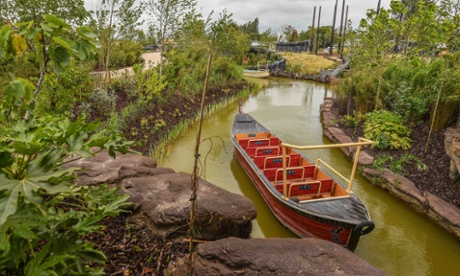
Since ancient Egyptians put exotic animals on display, humans have been gawping at and studying species from far beyond their own habitats. Today’s zoos, however, need to do much more than offer freak shows or modern arks. To remain acceptable in the public eye they must embrace conservation and education.
Judged by these modern standards, Chester Zoo, in the north-west of England, can lay claim to being one of the best: it was ranked first in the UK and seventh in the world in this year’s Trip Advisor Travellers’ Choice awards. It is also widely respected for its breeding programmes and conservation work in the native countries of species it exhibits.
Now it is expanding again, opening six small replicas of islands in south-east Asia – a species-rich and diverse region but one also undergoing systematic devastation of its biodiversity from hunting and destruction of habitats. For this reason, some species are the subject of breeding programmes at the zoo and in their native countries. Another feature that makes these islands so fascinating is that the animals have evolved into entirely separate species – many unique. Such distinctions helped form the evolutionary theories of pioneering British naturalist Alfred Wallace.
But, for most visitors, the main attraction will be a chance to take a walk or boat ride among crocodiles, turtles, Sumatran tigers, orangutans, prehistoric and dangerous (flightless) cassowary birds, and many other species, as well as through bamboo copses, rice-paddies and monsoon forest. My visit, just a few days after the Islands officially opened, allowed for an immersive experience of the first four islands to be finished. The fifth, Bali, was nearly constructed, and Sumatra and the monsoon forest are scheduled to open later this summer.
So, for our visit, only a handful of species had been relocated to the exhibit: we saw warty pigs and shy cassowary, but the miniature banteng cattle and midget anoa buffalo were too good at hiding. Meanwhile, the vegetation is mostly stumpy and patchy, not yet the engulfing and noisy environment it should become.
For my small children – Lucy is four and Thomas is two – this was not ideal, but they managed to find delight in unexpected ways: brightly painted fishing boats on the “Coral Beach”, where visitors arrive at the new experience; the entertainingly named warty pigs on the first island, Panay; the novelty of the Lazy River boat trip; a faked crocodile track into the water. A digger finishing preparations on “Bali” prompted a cry of delight from the toddler.
Distances are walkable but it is worth timing the trip carefully with young children or older relatives, as the queue for the 14 boats was considerable on a Saturday morning.
For adults, and hopefully older children, it is not too early to be animated by the story the Islands is trying to tell. There are already plenty of props and signs of how complete the experience could become: a riverside village washing station, rickety-looking bridges, surround-sound bird calls, an intricately carved chest, rudimentary paths past isolated huts or through a bustling village on Sulawesi. These all created a real sense of place. It is not hard to imagine how enveloping these sights and sounds will become in time – the animals should mostly be relocated this summer, while the vegetation will mature over years – and how thoroughly the experience could then stimulate the visitor’s imagination.
The Islands tour finishes at Manado Town Asian Street Market, where food is freshly cooked in open kitchens and eaten outside. We didn’t try this, having failed to convince the children that noodles were basically “nice pasta”. But the zoo’s main restaurant complex had a very adequate section of actual pasta, the usual fast foods with chips, sandwiches and even boxed salads and fresh fruit.
After that, we still had the rest of the zoo’s 12,000 animals to see. We concentrated on “obvious” animals – those most likely to feature in picture books. Family highlights included baby elephants playing in a muddy watering hole; feeding time for the giraffes, which drew them to within a couple of metres of us; sultry lions; watching penguins swim and do barrel-rolls; and the almost uncomfortable sense of voyeurism watching a troop of chimpanzees. They gave an astonishing display of rope swinging, altercations, gestures of what looked like reassurance, toilet breaks and what my daughter was certain was playing trains (but may well result in a few baby chimps).
Zoos are still controversial. Some people simply feel uncomfortable with animals in captivity; others argue that they over-claim the extent or benefits of conservation work and give visitors a false sense of security about the fate of wildlife. However, even critics agree that good zoos can do this well and Chester is, by all accounts, one of them.
The Islands could become a genuinely valuable demonstration of evolution, the rich web of ecology and the challenges of modern conservation. It will take time to mature, though, physically and as a story.
Until then, there is the time-honoured attraction of watching charismatic apes scratch each other’s bottoms, a story retold many times on the train home – and ever since.
• Chester Zoo and Marketing Cheshire provided the trip. Chester Zoo (chesterzoo.org) is open every day except Christmas Day and Boxing Day. Tickets cost £20-£28 for adults, £16.40-£24.80 for children over two, concessions and family rates are also available

